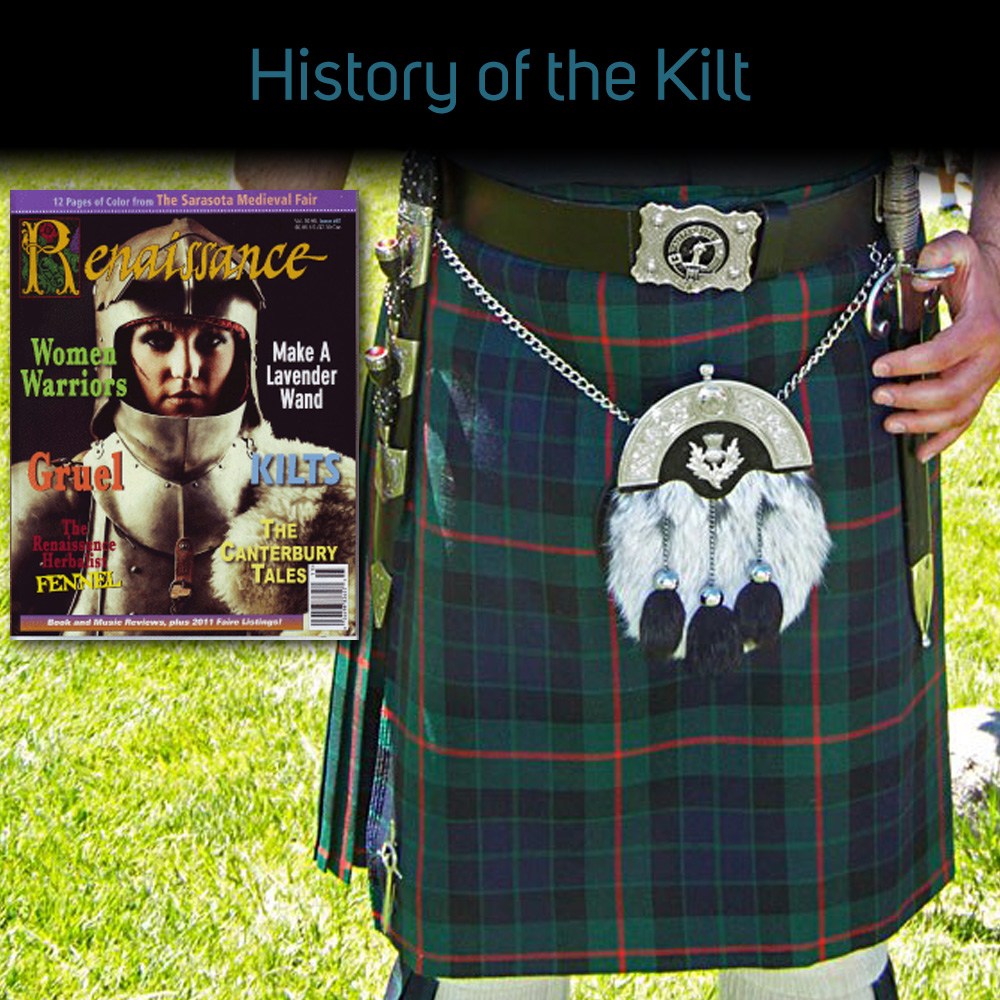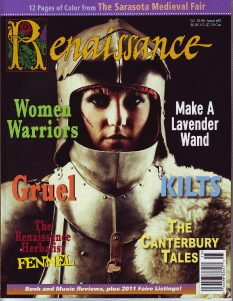Time to pull another fun one from the archives! This article first appeared in issue #81 (November 2011) of Renaissance magazine. None of the photos here appeared in the magazine; they own their pictures. The picture to the right is from a presentation I did for the Carbon County Historical Society on the history of kilts. I also covered much of this material in a guest visit to a local high school, where I explained that everything they saw in Braveheart was wrong.
There is no more recognizable symbol of Scotland than a man in a kilt. If you wish to celebrate your Scottish heritage at the next Renaissance festival you attend, a kilt is the obvious choice, and we all know the ladies love a man in a kilt!
If you look up one of the many suppliers of Celtic garb, you’ll find a dazzling array of tartans, and a length of accessories as long as your arm. Kilt hose, gillies, flashers, sgian dubh, sporran, kilt pin, belt, clan buckle, dirk—and that’s just what goes below your waist. If you have the cash, a modern kilt is easy to find, comfortable to wear, and easy to accessorize.
The problem is that the entire ensemble is an invention of the 19th century. If you wish to dress true to period, then you’ll need to dig a bit deeper into the history of the garment and the fabric it’s made from.
THE TARTAN
A tartan pattern, known as a “plaid” in the United States, consists of alternating colors at right angles to each other, creating anything from simple checkered patterns to complex collections of colored bands.
Tartans have actually been around at least as long as the Celts, and many centuries before Scotland existed as a nation. A proto-Celtic population known as the Hallstatt culture produced textiles similar to modern tartans. The earliest-known tartan in Britain dates back to the third century. Known as the “Falkirk tartan,” it was found in a pot full of Roman coins near the Antonine Wall in what is now Stirlingshire, Scotland.
The Falkirk tartan was a basic checkered design using natural (un-dyed) dark and light wool in an alternating pattern. It is less complex than modern tartans, but it shows that the tartan was, indeed, worn well before the Renaissance began.
Not much is known about how the tartan evolved or how it was worn through most of the early history of Scotland. The earliest known picture of Scottish men wearing tartan fabrics is a woodcut from the early fifteenth century.
Modern tartan cloth is made much the same way today as it was made centuries ago. The wool is spun and pre-dyed. Generally speaking, when the loom is set up, the same pattern of colored thread (known as the “sett”) is used for the warp and the weft. The threads for the warp are arranged and stretched, and the weft follows the same pattern. Where threads of the same color cross, a solid color results. Where different colors cross, a diagonal pattern of a blended color emerges.
In some tartans, the sett is simply repeated across the width and length of the fabric: so many threads of the first color, followed by so many of the second color, and so forth. In most tartans, though, alternating setts are reversed so that the tartan looks the same when reversed or rotated.
Master weavers developed their signature tartan using natural dyes found in their area, and the tartans came to identify specific islands or regions. By looking at a tartan, you could tell where it was made. Men made no effort, though, to dress like their kinsmen. Early paintings show that not only did groups of Scots not all wear the same tartan, but each Scotsman was likely to wear more than one tartan at a time, depending on his taste.
It was not until the Victorian era in the mid-nineteenth century that tartan registries were established and the clans chose tartans that were unique to their members. Each clan today is likely to have at least two registered tartans. The “modern” tartan uses synthetic dyes with bright colors, and the “ancient” tartan either uses authentic natural dyes or synthetics with muted colors to simulate aging. Some clans will also have a “hunting” tartan with more earthy or subdued colors, and occasionally a “dress” tartan, where one of the prominent colors in the sett is replaced with white.
What does all of this mean to you? It means that matching your highland garb to a particular era does not require selecting a tartan to match a clan, or even a region. Choose what you like, as long as you go with an “ancient” tartan pattern. Avoid the bright colors, especially bright green, which was difficult to produce. Natural colors (gray, brown, beige) were very common, as were yellow, red, purple, and blue.
THE BIRTH OF THE KILT

If you have seen the Mel Gibson movie, “Braveheart,” about Scottish patriot William Wallace, please forget everything you saw. The common garb of Scottish and Irish men in the late 11th century would have been a saffron-dyed knee-length tunic known as a léine. In colder weather, they would add a cloak known as a brat. There were no kilts at the Battle of Stirling in 1297.
The brat was a cumbersome heavy woolen garment. It may have been plain wool or tartan, and some men used fur or leather. Typically worn over the shoulders, it could be pinned in front or draped loose.
At some point, probably in the 1500s, someone came up with the idea of draping the brat around the waist and fastening it with a belt, and thus was born the “breacan an feile” or belted plaid, typically known today as a great kilt. The first written reference to the great kilt comes from 1594. By that time, the Scots had a distinctive look, no longer the same as the Irish.
Looms of the day typically produced fabric about 25 to 30 inches wide. To make a belted plaid, they would start with a piece of fabric about nine yards long. The actual unit of measurement then was called a “Scottish ell,” and was about 37 inches—the length of a man’s arm. They would cut the fabric in half and stitch it together to form a piece 4-5 feet wide and roughly 4-1/2 ells long.
To wear a belted plaid, men would lay their belt on the ground or on a bed and spread the fabric over it. They then gathered the center of the garment into pleats. The word “kilt” is actually derived from the old Norse word “kjalta,” which means pleat or fold. These distinctive pleats down the back of the kilt are what differentiate it from earlier garments. Once enough fabric had been pleated, the remainder could be wrapped over the front and the belt fastened.
Upon standing up, the upper part of the kilt would fall over the belt, creating double thickness of fabric and leaving the léine uncovered on the upper body. In warm weather, the highlander would leave it this way, or gather the ends of the upper fabric and tuck it into the belt to create two big pockets. In cooler weather, he would pull the upper fabric up over one shoulder and pin it. In rainy weather, it could be pulled all the way up as a hood.
If you are dressing for the latter part of the Renaissance era, the belted plaid is the most appropriate form of kilt to wear. As I mentioned above, there’s no need to worry about the particular tartan. Choose one that you like, or be a true Scotsman and find a cheap one on sale!
THE MODERN KILT

A short kilt, known in Gaelic as the feilidh beag (meaning “little wrap”), was effectively the bottom half of a great kilt. It was most likely developed sometime in the late seventeenth century. The name was Anglicized to “philabeg,” an inexpensive and lightweight alternative to a great kilt. They were still untailored, with the fabric loosely gathered, pleated, or folded in back.
In 1746, following the Jacobite uprisings, the British Parliament enacted the Dress Act, which forbid the wearing of kilts or tartans, along with other aspects of Highland culture. When the Act was repealed in 1782, the tartan kilt became the de facto official outfit of Scotland.
The kilt as we know it today came about shortly thereafter. The Scottish Tartan Society has a kilt from 1792 that is tailored, with the pleats stitched down. If you are attending a fantasy faire or a ren faire that doesn’t worry much about historic accuracy, a philabeg is probably your cheapest alternative, as it only requires half the cloth of a great kilt and uses no tailoring. A good modern kilt is substantially more expensive.
The term “short kilt” does not refer to the length when worn. Whether you have a great kilt, philabeg, or modern kilt, it should come to the middle of the knee. Above-the-knee tartan skirts are for women only.
ACCOUTREMENTS
Highlanders in the Renaissance were poor people. Few could afford shoes, and those that had them wore them only in cold weather. Traditional shoes or boots for a Highlander were thin leather with no heels, and may have either leather or cloth uppers laced together. The sporran of the era was a simple pouch strung around the waist.
The question most frequently asked when I’m wearing a kilt is what I have on under it. Much is made of the “correct” way to dress under your kilt, but there is no mandated answer. It’s like asking a modern man, boxers or briefs? On a warm day, you may wish to wear as little as possible. On a cold day, you’d want a bit more for warmth. Scottish athletes almost always wear undergarments to avoid exposing themselves.
My advice is to wear what you’re comfortable with, and if the ladies ask what’s under your kilt, ask them what’s under their dress!



